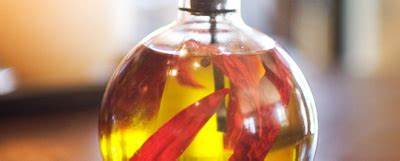



Manufacture and Use Of Hydrosols
For the early distillers who could barely grow enough roses or produce as much hydrosol as was demanded by their wealthy clientele, the issue of storage was unimportant. Let us assume that the hydrosols either were used quickly so they never had time to "go off" or were stored like foods, in cellars or cooler environments and in clay vessels, since evaporation through the clay would help keep the contents cool.
The waters, being far less expensive than the oils became the product that filtered its way into general use. One of the ways they were used was in cooking. Desserts were heavily fragranced with honey, spices, and waters of rose and orange blossom.
But again, in these times we must assume either that the waters were produced and used so quickly that spoilage was uncommon or, and perhaps more correctly, that even if they developed bacteria or "went off" they were used anyway.
Modern research shows that large quantities of ground clove bud added to contaminated meat can render it completely safe for human consumption while not destroying its palatability. But except for a few hydrosols like rose, neroli, sage, and oregano, interest in the waters and their value waned as the value of the oils was recognized.
The end of the nineteenth century saw the discovery of the germ. Science entered our lives, and essential oils proved themselves worthy of study not only as substances that could kill these germs but as compounds of interest in the pursuit of chemical knowledge.
Much of the first research in biochemistry was done with essential oils. They were already highly refined, and it was easier to isolate their parts than those of the whole plant. During the modern renaissance of aromatherapy, the oils naturally became the first substances to regain popularity.
For all the same reasons that they were desired in the past, oils came to mean aromatherapy, and vice versa. But as with renaissance, as time goes by, interest broadens and people seek greater understanding and more diversity in knowledge.
Now, at the end of the millennium, we see the rebirth of interest in plant waters, and one day they may be a form of aromatherapy completely independent of the oils.
Reference: Hydrosols The Next Aromatherapy: Suzanne Catty
Articles - Most Read
- Home
- What are Hydrosols
- What are Hydrosols-2
- The Monographs
- How to Make a Hydrosol
- Table of Common Latin Names and pH Values - F - O
- Distilled or Extracted Specifically For Therapeutic Use - 3
- What isn't a Hydrosol?
- Kurt Schnaubelt
- Table of Common Latin Names and pH Values - P - S
- Wholly Water!
- Blue Babies
- Mature Skin
- Supply and Demands
- Recipes Alpha F
- Hydrosols In The Marketplace
- Hemorrhoids
- Nelly GrosJean
- Water as Medicine
- Chemicals: Friends or Foes?
- Genitically Modified Plants
- Water Quality
- Influences
- The Educated Consumer
Articles-latest
- Comptonia peregrinal/Sweet Fern- pH 3.8
- Citrus clementine (fe) Clementine Petitgrain- pH 4.3-4.4
- Citrus aurantium var. amara (flos) /Neroli Orange Blossom-pH3.8-4.5
- Cistus ladaniferus/Rock Rose-pH 2.9-3.1
- Cinnamomum zeylanicum (ec) Cinnamon Bark-pH3.3
- Chamaemelum nobile/Roman Chamomile - pH 3.0-3,3
- Centaurea cyanus/Cornflower/Bachelor's Button-pH 4.7-5.0
- Cedrus atlantical/Cedarwood/Atlas Cedar-pH 4.1- 4.2
- Hydrosols -The PH - Anomalies
- Hydrosols- Establishing Shelf Life and Stability
- Boswellia carterii/FRANKINCENSE
- Asarum canadense/ Wild Ginger/Canadian Ginger
- Artemesia vulgaris / Artemesia
- ARTEMESIA DRACUNCULUS - TARRAGON
- Angelica archangelica / Angelica Root - Hydrosols
- The Key, or More Correctly, the pH - 2 - Hydrosols
- The Key, or More Correctly, the pH-Hydrosols
- The Hard pHacts - Hydrosols
- Calamus Root/Sweet Flag - ACORUS CALAMUS
- Yarrow - Achillea millefolium - Hydrosols
- Balsam Fir - Abies balsamea - Hydrosols
- How the Monograps are Presented
- The Three-Week Internal Protocol - Hydrosols
- Protocols - Hydrosols

